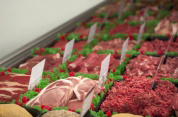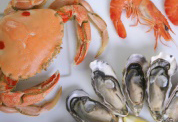The importance of food authenticity
Since the beginning of 2013 and the outbreak of the horse meat scandal, food adulteration and food authenticity came into focus. It is essential to reassure the public and ensure that there are no uncertainties or loss of trust. Eurofins offers the possibility to detect mislabeled products from farm to retail chain.
Eurofins has been pioneering DNA-based analytical technologies for food testing using innovative protocols to improve the safety and authenticity of our clients' food products for over 10 years and has gained a lot of experience in DNA-based food testing. Additionally, the Eurofins Food division is also able to test for food authenticity by protein ELISA or can detect contaminants, drug residues, pesticides, etc. in food products.
The qualitative and quantitative food and feed DNA testing portfolio of Eurofins Genomics ranges from farm to retail, from raw material to highly processed food products:
- Meat authenticity testing
- Fish and seafood authenticity testing
- Plant authenticity testing, e.g. rice
Through the Eurofins network we are able to provide the largest testing capacity (thousands of samples per day) and shortest turn-around-times (TAT of 72 hours) of any independent food testing service provider.
For further information, just contact us!


Responding to horse meat scandal
Eurofins offers the complete analytical portfolio to ensure the safety and authenticity of meat
Adulteration and authenticity of meat and now also other products have been making the headlines with horse and pig meat found in UK and Irish beef products and now in several other countries.
The EU Commission initiated an EU-wide program of control measures including random control of processed beef products for foreign DNA as well as analysis of residues of the veterinary drug phenylbutazone ("bute"). Horses that have been treated with the drug phenylbutazone are not allowed to enter the food chain.
Eurofins - pioneer in DNA-based analytical technologies for meat testing
Over 10 years experience using innovative protocols to improve the safety and authenticity of our clients' food products.
Eurofins offers several accredited specialist services for meat species testing:
- Semi-quantitative DNA species testing by means of Real-Time PCR, and confirmation by DNA sequencing
- Qualitative DNA species testing by means of PCR and DNA sequencing
- Qualitative DNA species testing by means of Real-Time PCR
- ELISA tests - screening test that may not be suitable for all matrices and processing levels
The selective and sensitive detection of phenylbutazone is achieved using Tandem-LC-MS. This is just one of the many Veterinary Drug Residues Eurofins is able to test for in its Competence Centre for Vetinary Drug Residue testing.
Eurofins is currently the only international laboratory network capable of performing all ISO 17025 accredited DNA detection of both horsemeat and of phenylbutazone, and potential presence of many other species and a comprehensive range of veterinary drugs and contaminants.
Eurofins molecular biology offer includes also Eurofins TAG - a traceability system that allows the tracing of meat back to an individual animal. Eurofins TAG is a simple and low-cost method that has proven its effectiveness in a large trial involving over 14,000 animals.
Strict confidentiality is ensured by every project. The high quality of our service is overseen by a professional and certified quality management team.
For further information, just contact us!

The BBC interviewed Dr Bert Popping at our Eurofins laboratory in Hamburg about the meat contamination issue and comments on how horse meat could have ended up in ready meals.



Mislabeling of fish and seafood products is common
To detect mislabeling Eurofins offers a broad range of DNA-based molecularbiological applications to determine fish authenticity
Several studies by the worldwide Oceana organization showed that fish fraud occured everywhere and in a high percentage. 59% of fish types are mislabeled and snapper and tuna are the fish types where this happened most common.
Eurofins can help to identify mislabeled fish and seafood products by qualitative DNA-based methods using PCR and sequencing of mitochondrial genes.
Flexible & fast: our fish and seafood testing
With the universal DNA sequencing method we determine the species of
- fresh and frozen fish
- seafood
- fish eggs and caviar
- fish products, such as fish on pizza, canned fish or ready meals
Our approach enables us to distinguish all common fish and seafood species as well as exotic fishes; e.g., in 2012 we detected more than 60 different fish species over all tested samples. For more than 90% of the analyses we yield sufficient DNA to unequivocally determine which fish species is in the sample.
All commonly consumed fishes and seafood species can be detected, e.g. Salmon, Herring, Perch, Whiting, Plaice, Pollock, Hake, Sturgeon, Haddock, Tilapia, Cod, Prawns, Tuna fishes, Shrimps, Sole, Mussels, Flat fishes, Lobsters, Tusk…and many more.
Special - tuna cans
The most common tuna species in cans or on pizza is Katsuwonus pelamis (Skipjack tuna), which we is reliably detected as well as Big Eye tuna (Thunnus obesus), Yellow Fin tuna (Thunnus albacares), White tuna (Thunnus alalunga), Blue Fin tuna (Thunnus thynnus), Little tuna species (Euthynnus spp.) and many more species.
The Codex Alimentarius for tuna fish in cans (Codex Stan 70-1981) and the EC regulation no. 1536/92 of common marketing standards for preserved tuna and bonito regulate which species can be labelled as tuna. This applies to several Thunnus and Euthynnus species as well as to Katsuwonus pelamis. The EC regulation prohibits the mixture of different fish species in one can. Additionally, the proportion of chunks and flakes of the different quality stages
is defined: a can labelled “chunks” can contain up to 30 % tuna flakes. These flakes are obtained from sections of fish filet and are not allowed to be smaller than 1.2 cm.
Strict confidentiality is ensured by every project. The high quality of our service is overseen by a professional quality management team. We are certified according to ISO 17025 and compliant with GLP.


Is your Basmati/Thai rice or your spice authentic?
Eurofins offers a broad range of DNA-based molecularbiological applications to determine plant product authenticity
Using cheaper or less quality plant components in upscale plant products increase the profit for the manufacturer. Anyhow, this lead to consumer fraud and is forbidden in most of the countries.
Eurofins can help to identify mislabeled plant products by different DNA-based analytical methods like microsatellite analysis as well as PCR and sequencing of mitochondrial genes.
Rice authenticity testing
This test approach detects and quantify the presence of non-Basmati-rice as well was non-Thai-rice mixed with Basmati or Thai rice, respectively, usind microsatellite DNA-analysis. It can be used with non-cooked as well as with cooked rice. If required, it also checks if the Basmati or Thai variety labelled on the package is correct.
Basmati (from the Hindi word for fragrant) is the customary name for certain varieties of rice with unique properties that are grown exclusively in specific areas of the Indo Gangetic Plains of northern India and Pakistan. The UK FSA’s guidance and the Indian and Pakistani authorities recommend that the term 'Basmati' should only be used to refer to 11 Indian and 5 Pakistani rice varieties that display typical Basmati properties. Basmati rice attains a higher price than non-Basmati-rice in both wholesale and retail markets. In March 2004, the UK Food Standard Agency published a study on Basmati rice. 46 % of all Basmati is adulterated to some degree, the research found that almost 80 % either did not contain the variety advertised on the packet or it made up only a minor component.
In Thailand Jasmine (also named fragrant or scented rice) is cultivated in two main varieties: Thai Hom Mali rice is the traditional variant with the better quality, which can also be stored over longer periods. Consequently, it has a higher sales price. Hom Mali is only cultivated from June to December in the lower North Eastern part of Thailand. The traditional variety Kao Dok Mali 105 and its derivative Gor Khor 15 are officially registered as Thai Hom Mali rice.
In the opposite, Pathumthani 1 as another Kao Dok Mali 105 derivate to be commercialised under the name "Pathumthani". Its cultivation is not bound to certain regions or seasons. Pathumthani is cheaper than Hom Mali. Hom Mali and Pathumthani can be distinguished by a new DNA microsatellite fingerprint.
Our screening enables rice importers to determine the authenticity of their products quickly and reliably what lead to a long-term increase in product faith of the retailers and consumers.
General plant authenticity testing
Beside rice authenticity testing, Eurofins Genomics offers several other qualitative plant species tests to identify them in a plant product:
- General plant species determination, e.g. for spices
- Pine nut authenticity
- Garlic authenticity
- Ginger authenticity
- Allium authenticity
- Marzipan vs. Persipan
- Saffron
Generally, we can set-up any test that is desired.
Strict confidentiality is ensured by every project. The high quality of our service is overseen by a professional quality management team. We are certified according to ISO 9001 and ISO 17025 and compliant with GLP.